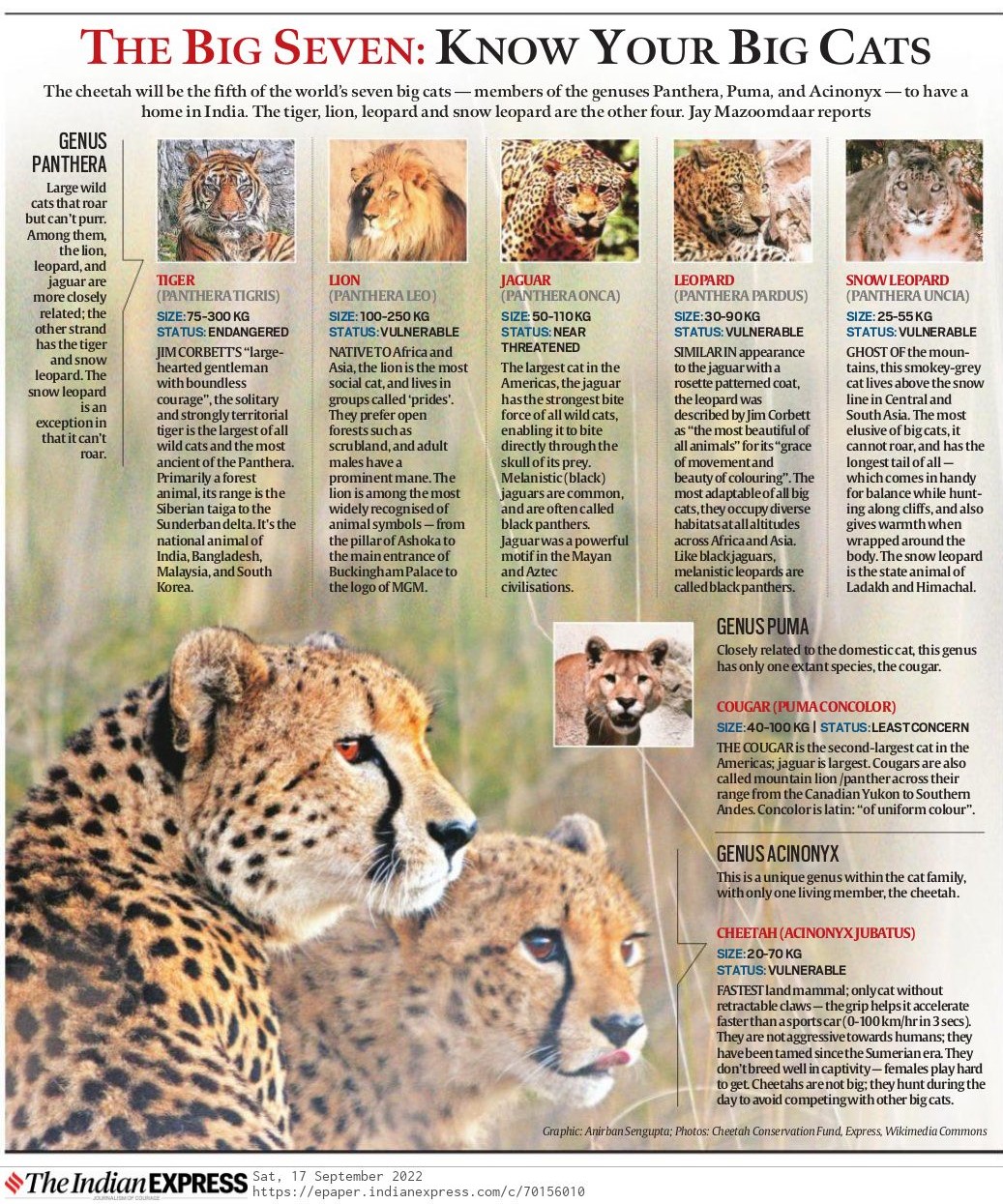Article Title: Cheetah Reintroduction Program
17-09-2022
Environment & Ecology Current Affairs Analysis
What’s in News?
Eight African cheetahs from Namibia — five females and three males between the ages of 4-6 years — will be flown to India and will be released in the Kuno National Park in Madhya Pradesh as part of India’s Rs 90-crore Cheetah Introduction project.
This is the first time in the world that a large carnivore will be relocated from one continent to another.
Background:
- The historical range of the cheetah in India encompassed the entire country except the high mountains, coasts and the northeast region; from west of Bengal in the east to west of Pakistan into Afghanistan and Iran in the west and from Punjab in the north to north western Tamil Nadu in the South
- Cheetah happens to be the only large carnivore that got completely wiped out from India
- The main reasons for the decline of cheetah in India were large scale capture of animals from the wild for coursing, bounty and sport hunting, extensive habitat conversion along with consequent decline in prey base
- The name ‘cheetah’ is believed to have originated from Sanskrit word chitrak, which means ‘the spotted one’.
Extinction of Cheetah in India:
- The Asiatic cheetah was declared extinct in India in 1952 and is a critically endangered species surviving only in Iran.
- In 1947, there were confirmed records of the cheetah’s presence in India, but the three surviving males were gunned down by Maharaja Ramanuj Pratap Singh Deo of Surguja state in what is now Guru Ghasidas National Park in Chhattisgarh.
- Since the 1940s, the cheetah has gone extinct in 14 other countries – Jordan, Iraq, Israel, Morocco, Syria, Oman, Tunisia, Saudi Arabia, Djibouti, Ghana, Nigeria, Kazakhstan, Pakistan and Afghanistan
Habitat and importance:
- Cheetahs live in open plains; their habitat is predominantly where their preys live - grasslands, scrubs and open forest systems, semi-arid environments and temperatures that tend to be hotter compared to cooler regimes.
- Cheetah can also live in a wide range of habitats, which includes coastal scrubs, wooded savannah, Montane habitat, snow deserts and rugged semi-arid areas.
- In saving cheetahs, one would have to save not only its prey-base comprising certain threatened species, but also other endangered species of the grasslands and open forest ecosystems, some of which are on the brink of extinction.
- It is also observed that among large carnivores, conflict with human interests is lowest for Cheetahs.
- They are not a threat to humans and do not attack large livestock either
Re-introduction of Asiatic Cheetah:
- Amongst the 10 surveyed sites of the central Indian states, Kuno Palpur National Park (KNP) in Madhya Pradesh has been rated the highest.
- This is because of its suitable habitat and adequate prey base. KNP is 748 sq. km. in area, devoid of human settlements, forms part of Sheopur-Shivpuri deciduous open forest landscape and is estimated to have a capacity to sustain 21 cheetahs.
- Kuno also offers the prospect of housing four big cats of India - tiger, lion, leopard and cheetah – and allowing them to coexist as in the past.
- The other sites recommended for holding and conservation breeding of cheetah in India, in controlled wild conditions are:
- Nauradehi Wildlife Sanctuary, Madhya Pradesh
- Gandhi Sagar Wildlife Sanctuary – Bhainsrorgarh Wildlife Sanctuary complex, Madhya Pradesh
- Shahgarh bulge in Jaisalmer, Rajasthan
- Mukundara Tiger Reserve as fenced enclosure, Rajasthan
Significance of the move:
- The aim behind the translocation is not only to restore India’s ‘historic evolutionary balance’, but also to develop a cheetah ‘metapopulation’ that will help in the global conservation of the animal.
- As it is a flagship species, the conservation of the cheetah will revive grassland-forests and its biome and habitat, much like Project Tiger has done for forests and all the species found in these forests.
- Project Tiger has also resulted in the conservation of 250 water bodies found in India’s 52 Tiger Reserves.
- The Cheetah Project is likely to have a similar impact.
- The Asiatic cheetahs in India were one of the apex predators of grasslands and open natural ecosystems (ONEs), having coevolved with the blackbuck and chinkara.
Concerns:
(i) Gene Flow and Genetic Diversity:
- The gene flow in such a small group of cheetahs is a matter of concern.
- Gene flow between populations can help maintain genetic diversity and prevent inbreeding, which is especially important for small and fragmented habitats.
- (gene flow is the transfer of genetic material from one population to another)
- It is often difficult to find genetically suitable animals, particularly for building a new population, when the source population itself is closely related.
- This can lead to inbreeding depression in the new population.
(ii) Habitat and Prey Base:
- The factors that caused a species to lose numbers or go extinct must be dealt with to secure the habitat, before restocking so that colonies of reintroduced animals become large enough as quickly as possible to withstand fluctuations in both the environment and population size.
- Physical security, enough space, and ample food are the priorities.
(iii) Landscape Viability:
- Simply releasing and moving animals between pocket forests can at best halt further habitat fragmentation in the name of a charismatic species.
- Even if such assisted exchanges succeed in ensuring genetic viability, animals will remain susceptible to demographic and environmental events in such a broken landscape.
Way Forward:
- Over the next five to 10 years, 5-10 cheetahs will be relocated to India annually.
- Over the coming 15 years, the Indian government will acquire two to four cheetahs from Africa, with the process undertaken at an interval of one to four years, to establish a breeding cheetah metapopulation of 35-40 in the country.
- Once the population in Kuno National Park has adapted and is flourishing, the Indian government will expand the efforts to reserves in other parts of the country as well.

 "UPSC-2026-PRELIMS COMBINED MAINS PROGRAMME" NEW BATCH STARTS WITH ORIENTATION ON JULY 7th,2025
"UPSC-2026-PRELIMS COMBINED MAINS PROGRAMME" NEW BATCH STARTS WITH ORIENTATION ON JULY 7th,2025 